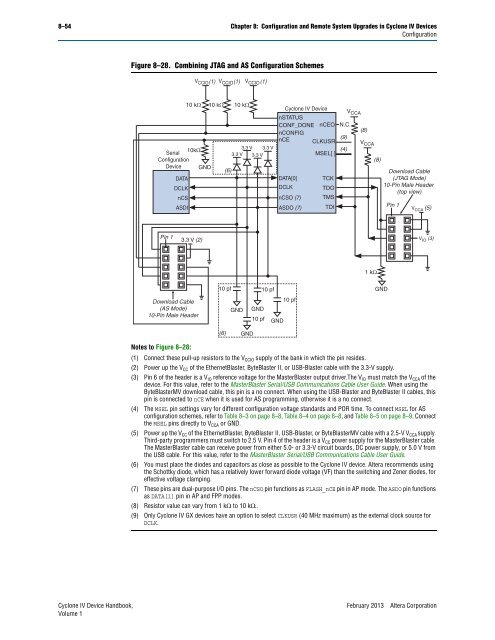Configuration and Remote System Upgrades in Cyclone IV ... - Altera
Configuration and Remote System Upgrades in Cyclone IV ... - Altera
Configuration and Remote System Upgrades in Cyclone IV ... - Altera
You also want an ePaper? Increase the reach of your titles
YUMPU automatically turns print PDFs into web optimized ePapers that Google loves.
8–54 Chapter 8: <strong>Configuration</strong> <strong>and</strong> <strong>Remote</strong> <strong>System</strong> <strong>Upgrades</strong> <strong>in</strong> <strong>Cyclone</strong> <strong>IV</strong> Devices<br />
<strong>Configuration</strong><br />
Figure 8–28. Comb<strong>in</strong><strong>in</strong>g JTAG <strong>and</strong> AS <strong>Configuration</strong> Schemes<br />
Serial<br />
10kΩ<br />
<strong>Configuration</strong><br />
Device GND<br />
P<strong>in</strong> 1<br />
DATA<br />
DCLK<br />
nCS<br />
ASDI<br />
Notes to Figure 8–28:<br />
VCCIO (1) VCCIO (1) VCCIO (1)<br />
10 kΩ<br />
3.3 V (2)<br />
Download Cable<br />
(AS Mode)<br />
10-P<strong>in</strong> Male Header<br />
10 kΩ<br />
10 pf<br />
(6)<br />
(6)<br />
10 kΩ<br />
3.3 V 3.3 V<br />
3.3 V 3.3 V<br />
GND<br />
GND<br />
10 pf<br />
GND<br />
10 pf GND<br />
<strong>Cyclone</strong> <strong>IV</strong> Device<br />
nSTATUS<br />
VCCA CONF_DONE nCEO<br />
nCONFIG<br />
nCE CLKUSR<br />
MSEL[ ]<br />
N.C.<br />
(4)<br />
VCCA (9)<br />
(8)<br />
(8)<br />
(1) Connect these pull-up resistors to the VCCIO supply of the bank <strong>in</strong> which the p<strong>in</strong> resides.<br />
(2) Power up the VCC of the EthernetBlaster, ByteBlaster II, or USB-Blaster cable with the 3.3-V supply.<br />
(3) P<strong>in</strong> 6 of the header is a VIO reference voltage for the MasterBlaster output driver.The VIO must match the VCCA of the<br />
device. For this value, refer to the MasterBlaster Serial/USB Communications Cable User Guide. When us<strong>in</strong>g the<br />
ByteBlasterMV download cable, this p<strong>in</strong> is a no connect. When us<strong>in</strong>g the USB-Blaster <strong>and</strong> ByteBlaster II cables, this<br />
p<strong>in</strong> is connected to nCE when it is used for AS programm<strong>in</strong>g, otherwise it is a no connect.<br />
(4) The MSEL p<strong>in</strong> sett<strong>in</strong>gs vary for different configuration voltage st<strong>and</strong>ards <strong>and</strong> POR time. To connect MSEL for AS<br />
configuration schemes, refer to Table 8–3 on page 8–8, Table 8–4 on page 8–8, <strong>and</strong> Table 8–5 on page 8–9. Connect<br />
the MSEL p<strong>in</strong>s directly to VCCA or GND.<br />
(5) Power up the VCC of the EthernetBlaster, ByteBlaster II, USB-Blaster, or ByteBlasterMV cable with a 2.5-V VCCA supply.<br />
Third-party programmers must switch to 2.5 V. P<strong>in</strong> 4 of the header is a VCC power supply for the MasterBlaster cable.<br />
The MasterBlaster cable can receive power from either 5.0- or 3.3-V circuit boards, DC power supply, or 5.0 V from<br />
the USB cable. For this value, refer to the MasterBlaster Serial/USB Communications Cable User Guide.<br />
(6) You must place the diodes <strong>and</strong> capacitors as close as possible to the <strong>Cyclone</strong> <strong>IV</strong> device. <strong>Altera</strong> recommends us<strong>in</strong>g<br />
the Schottky diode, which has a relatively lower forward diode voltage (VF) than the switch<strong>in</strong>g <strong>and</strong> Zener diodes, for<br />
effective voltage clamp<strong>in</strong>g.<br />
(7) These p<strong>in</strong>s are dual-purpose I/O p<strong>in</strong>s. The nCSO p<strong>in</strong> functions as FLASH_nCE p<strong>in</strong> <strong>in</strong> AP mode. The ASDO p<strong>in</strong> functions<br />
as DATA[1] p<strong>in</strong> <strong>in</strong> AP <strong>and</strong> FPP modes.<br />
(8) Resistor value can vary from 1 k to 10 k..<br />
(9) Only <strong>Cyclone</strong> <strong>IV</strong> GX devices have an option to select CLKUSR (40 MHz maximum) as the external clock source for<br />
DCLK.<br />
<strong>Cyclone</strong> <strong>IV</strong> Device H<strong>and</strong>book, February 2013 <strong>Altera</strong> Corporation<br />
Volume 1<br />
10 pf<br />
DATA[0]<br />
DCLK<br />
nCSO (7)<br />
ASDO (7)<br />
TCK<br />
TDO<br />
TMS<br />
TDI<br />
1 kΩ<br />
GND<br />
Download Cable<br />
(JTAG Mode)<br />
10-P<strong>in</strong> Male Header<br />
(top view)<br />
P<strong>in</strong> 1<br />
V CCA (5)<br />
V IO (3)
















